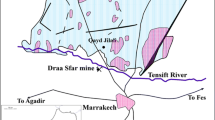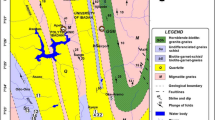Abstract
The lower Jia Bharali catchment and adjoining areas in central part of North Brahmaputra Plain (NBP) is characterized by more than 800m thick Older and Younger Alluvium deposited by the west flowing Brahmaputra river and the south flowing trans Himalayan rivers. Unconfined, shallow alluvial aquifers of the area with a general southward flow are largely tapped for domestic use through numerous dug well attached with almost every household. Monitoring of 180 dug wells for two hydrological years show strong seasonal fluctuation of the groundwater table linked to the summer monsoon that brings more than 1500mm precipitation in the area between June-September. This study has presents the first ever systematic database on toxic trace elements viz., As, Cr, Fe, Mn, Ni, Pb and Zn from the shallow aquifers in north Brahmaputra plain based on water samples from 50 monitoring wells collected in both dry and wet seasons. The data was analysed with respect to WHO standards for drinking water and significantly, 2 % of the measurements show As in excess of the WHO limit while 60% of the samples in the wet season and as much as 90 % of the same in dry season have Cr content more than the WHO permissible limit. Pb concentration is above permissible limit of 0.05 mg/L in most of the dry season samples although 88 % of the rainy season samples show Pb concentration exceeding this limit. 34 % of the samples in the wet seasons and 86 % of the samples in the dry seasons have Mn above the permissible limit of 0.1 mg/L while in case of Ni, 56 % of the aquifers in the wet season and 72 % of the aquifers in the dry season show Ni content above the permissible limit of 0.02 mg/L. Zn contents of the aquifers are however very low throughout the year.
Similar content being viewed by others
References
APHA, AWWA (American Public Health Association),. (1998) Standard methods for the examination of water and wastewater, American Public Health Association, Washington D.C.
Applin, K.R. and Zhao, N. (1989) The kinetics of Fe (II) oxidation and well screen encrustation. Ground Water, v.27, pp.168–174.
Bhagure Ganesh Ramdas and Mirganes, R. (2010) Heavy metal concentrations in groundwaters and soils of Thane Region of Maharashtra, India. Environ. Monit. Assess.
Giang Luu, T.T., Sthiannopkao, S. and Kyoung-Woong, K. (2009) Arsenic and other trace elements contamination in groundwater and a risk assessment study for the residents in the Kandal Province of Cambodia. Environ. Internat., v.35(3), pp.455–460.
GSI (1977) Contributions to geomorphology and geohydrology of the Brahmaputra valley. Geol. Surv India, Misc. Publ., No. 32, 291p.
Hem, J.D. (1976) Inorganic Chemistry of Lead in Water’. In: T.G. Lovering (Ed.), Lead in the Environment. USGS Prof. Paper, 957, pp.5–11.
Jain, S.K., Agarwal, P.K. and Singh, V.P. (2007) Hydrology and water resources of India. Dordrecht, The Netherlands: Springer (13-978-1-4020-5180-7, e-book).
Jarup, L. (2002) Cadmium overload and toxicity. Nephrology Dialysis Transplantation, 17(Suppl. 2), pp.35–39.
Klavins, M., Briede, A., Rodinov, V., Kokorite, I., Parele, E. and Klavina, I. (2000) Heavy metals in Rivers of Latvia. Sci. Total Environ., v.262, pp.175–183.
Mugica, V., Maubert, M., Torres, M., Munoz, J. and Rico, E. (2002) Temporal and spatial Variations of metal content in TSP and PM10 in Mexico City during 1996–1998. Jour. Aerosol Sci, v.33, pp.91–102.
Packham, R.F. (1996) Drinking water quality and health. In: R.M. Harrison (Ed.), Pollution, causes, effects and control. The Royal Society of Chemistry, UK, pp.52–65.
Pawar, N.J. and Nikumbh, J.D. (1999) Trace element geochemistry of ground water from Behedi basin, Nasik district, Maharashtra. Jour. Geol. Soc. India, v.54, pp.501–514.
Purushotham, D., Rao Narsing, A., Prakash Ravi, M., Ahmed, S. and Babu G. Ashok (2011) Environmental impact on ground water of Maheshwaram watershed, Ranga Reddy district, Andhra Pradesh. Jour. Geol. Soc. India, v.77, pp.539–548
Ramesh, R. and Anbu, M. (1996) Chemical methods for environmental analysis. Macmillan, India, 161p.
Romic, M. and Romic, D. (2003) Heavy metal distribution in agricultural topsoils in urban area. Environ. Geol., v.43, pp.795–805.
Ross, S.J. Jr., Franzmeier, D.P. and Roth, C.B. (1976) Mineralogy and chemistry of manganese oxides in some Indiana soils. Soil Sci. Soc. Amer. Jour., v.40, pp.137–143.
SEGH (2001) Environmental geochemistry and health special issue. In: 18th European Cnference, v.23, no.3.
Singhal, B.B.S. and Gupta, R.P. (1999) Applied Hydrogeology of Fractured Rocks. Kluwer Academic Publishers, The Netherlands, 400p.
Smedley, P.L. and Kinniburgh, D.G. (2002) A review of the source, behaviour and distribution of arsenic in natural waters. Appld. Geochem., v.17, pp.517–568.
Smith, A.H., Lopipero, P.A., Bates, M.N. and Steinmaus, C.M. (2002) Arsenic epidemiology and drinking water standards. Science, v.269, pp.2145–2146.
Uddin, M.M., Harun-ar-Rashid, A.K.M., Hossain, S.M., Hafiz, M.A., Nahar, K. and Mubin, S.H. (2006) Slow arsenic poisoning of the contaminated groundwater users. Internat. Jour. Environ. Sci. Tech., v.3(4), pp.447–453.
Unesco-Unep (1984) Hydrogeological Principles of Groundwater Protection. In: C. P. Young and J. N. Hutchinson (Eds.), UNESCO-UNEP Publ., v.I, 164p.
White, A.F., Benson, S.M., Yee, A.W., Woolenberg, H.A. and Flexser, S. (1991) Groundwater contamination at the Kesterson reservoir, California Geochemical parameters influencing selenium mobility. Water Resources Res., v.27, pp.1085–1098.
WHO (1984) Guidelines for drinking water quality. Health criteria and other supporting information, WHO Publ., v.2, Geneva, 335p.
WHO (2004) Guidelines for drinking-water quality. Geneva: World Health Organization, Vol. 1, 3rd Edition.
Yu, K.Y., Tasi, L.J., Chen, S.H. and Ho, S.T. (2001) Chemical binding of heavy metals in anoxic river sediments. Water Res., v.35(7), pp.406–409.
Author information
Authors and Affiliations
Corresponding author
Rights and permissions
About this article
Cite this article
Khound, N.J., Phukon, P. & Bhattacharyya, K.G. Dissolved trace metals in the shallow aquifers of the Jia Bharali River Basin, North Brahmaputra Plain. J Geol Soc India 82, 162–168 (2013). https://doi.org/10.1007/s12594-013-0134-3
Received:
Accepted:
Published:
Issue Date:
DOI: https://doi.org/10.1007/s12594-013-0134-3




